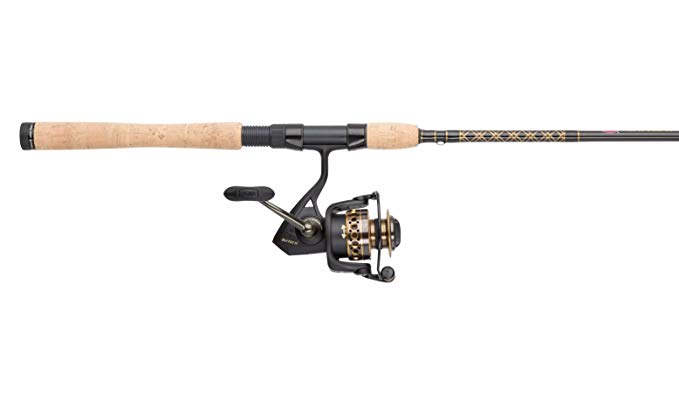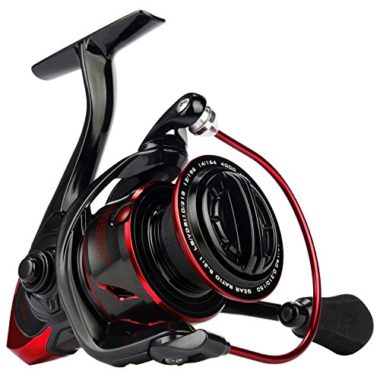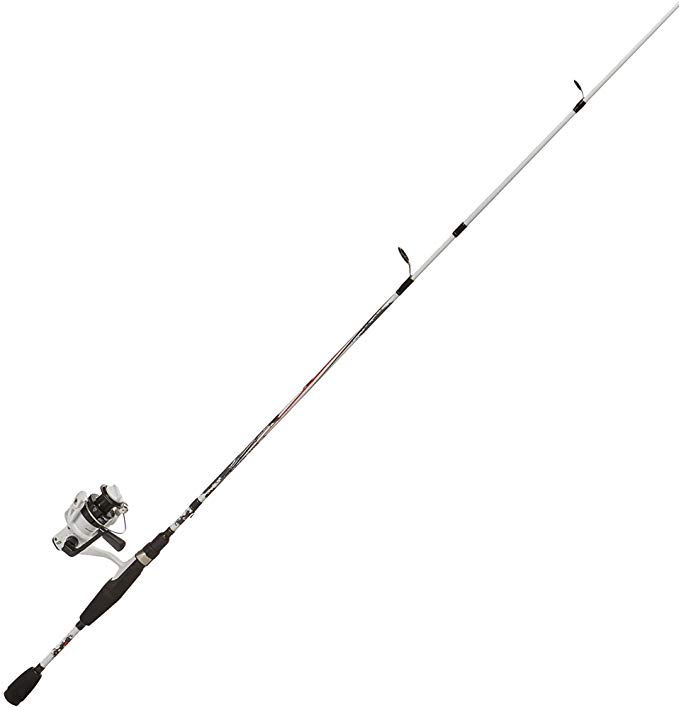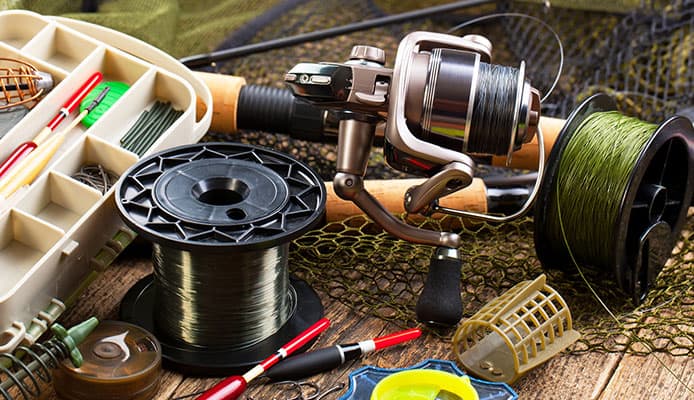
Bass fish tends to be a highly abundant species, thus, it is no wonder why it a common catch for many anglers. As much as they are an abundant and common species, bass also offers a good protein and flavor option with the just the right cook on the skin and fillet. Yet, their abundance doesn’t make these fish easier to catch. Thus, for a successful bass fishing experience, you need the right gear.
Bass rod and reel combos offer an ideal and cost-cutting fishing gear option. The best bass rod and reel combo are designed with the right size, construction design and feature just the ideal material to enhance the casting and retrieve results. Additionally, their pre-matched package enhances your chances of pairing up the right rod with its reel.
Listed below are the 8 best bass rod and reel combos in 2023. Each combo set outlines its unique features and why it’s the ideally matched set for your next bass fishing expedition. The choice is all yours to go for a set that appears most to you.
OUR TOP PICK
Penn Battle II

- Stand Out Features - Why We Love It
- Heavy duty aluminum bail wire
- Lightweight and powerful carbon fiber drag system
- Corrosion resistant full metal body, side plate, and rotors
- Machined and anodized aluminum spool
- Available in a variety of other sizes
Gear ratio: 6.2:1
Reel size: 40
Rod length: 7’
Maximum drag: 15lbs.
Mono/Braid line capacity: 12/30 lbs.
EDITORS CHOICE
Ugly Stik

- Stand Out Features - Why We Love It
- Lightweight fiberglass rod
- Patented Ugly Tech fiberglass and graphite construction
- Patented Ugly Tuff and highly durable aluminum guides
- Patented clear tip design enhances sensitivity and strength
- Affordably priced
Gear ratio: 4.1:1
Reel size: 20
Rod length: 4’8”
Maximum drag: 2-6lbs.
Mono/Braid line capacity: 6/10 lbs.
BEST VALUE
Plussino

- Stand Out Features - Why We Love It
- Collapses for easy travel and storage
- Adjustable length design
- Anti-sea water graphite and stainless steel construction
- Larger spool with larger line capacity
- S-curve oscillation system r effective line winding
Gear ratio: 5.2:1
Reel size: 40 – 60
Rod length: 5’9” – 8’86”
Maximum drag: 10 – 33lbs.
Mono/Braid line capacity: 8/11 lbs.
KastKing Centron

- Stand Out Features - Why We Love It
- Stainless steel guides with O-rings
- Contoured EV handles and fighting butt
- A triple disc drag system
- Stainless steel guide frame helps to balance rod
- Stronger CNC machined aluminum spool
Gear ratio: 5.2:1
Reel size: 20
Rod length: 6’6”
Maximum drag: 11lbs.
Mono/Braid line capacity: 8/14 lbs.
Abu Garcia Black Max

- Stand Out Features - Why We Love It
- Power disk system to improve drag
- Highly sensitive and lightweight 24-ton graphite rod construction
- Magtrax brake system enhances casting experience
- Ergonomic bent reel handle
- Recessed reel foot
Gear ratio: 6.4:1
Reel size: 20
Rod length: 7’
Maximum drag: 15lbs.
Mono/Braid line capacity: 12/30 lbs.
KastKing Sharky III

- Stand Out Features - Why We Love It
- Ideal for freshwater and saltwater use
- Highly effective Fuji O-ring line guides
- Lightweight EVA handle and fighting butt
- High weight capacity spinning reel
- 10+1 ultra smooth ball bearing system
Gear ratio: 5.2:1
Reel size: 20
Rod length: 6’6”
Maximum drag: 39.5lbs.
Mono/Braid line capacity: 8/14 lbs.
Abu Garcia Ike Dude

- Stand Out Features - Why We Love It
- 2-piece easy to transport and store composite rod construction
- Ambidextrous design
- Lightweight graphite body and rotor
- Comes pre-spooled with a 6lb. line
- Available in spinning and spin casting options
Gear ratio: 5.2:1
Reel size: 30
Rod length: 6’
Maximum drag: 15lbs.
Mono/Braid line capacity: 6/12 lbs.
Pflueger President Bass

- Stand Out Features - Why We Love It
- Lightweight and highly protective graphite body
- Soft touch knob
- Brain line ready spool
- Ideal for saltwater and freshwater fishing
- Sealed drag system for enhanced durability and function
Gear ratio: 5.2:1
Reel size: 30
Rod length: 6’
Maximum drag: 10lbs.
Mono/Braid line capacity: 4/10 lbs.
How To Choose A Rod And Reel Combo – Buying Guide

Strength of the rod and reel
When choosing the best rod and reel for bass, you must consider the strength of both the rod and the reel. The strength of the rod is basically how much power, force or load it takes to bend the rod. This all depends on the design of the rod whether it is ultra light or extra heavy as well as the weight of the catch the rod is supporting.
The reel strength on the other end denotes how much drag the reel can support. You can identify the strength of the reel through its size. Most commonly the lowest is around 1000 and goes all the way up to 15000. Different species of fish behave differently when being caught thus, they require different fishing set up, tools and seizes based on their weight, environment and the fight they put up.
Thus, when choosing an ideal rod for bass fishing, consider the water conditions as well as the bass itself. Typically, medium, medium heavy to heavy action fishing rod is ideal. And if you want to opt for extra smaller or larger bass, medium light or extra heavy rod will do.
The choice of the rod also means that the rod chosen becomes versatile, allowing you to also catch species that exhibit similar patterns such as trout, walleye, steelhead, and even salmon, for the heavy rod. The ideal reel size for your bass fishing on the other end should be anywhere between size 2000 and 3000.
You might also be interested in:
Rod Sensitivity
To enhance your fishing experience, the best rod and reel for bass combos must exhibit rod sensitivity. The sensitivity of your rod basically describes how easily you can detect when a fish bites or the bottom of the water source. Thus, sensitivity is an important factor for anglers. Graphite rods are considered to be the most sensitive of rods.
Their design equips them with the ability to easily transmit vibrations on the angler’s hand, even from the bottom of the water source. Additionally, different designs of graphite rods will also boast different intensities of sensitivity.
For example, softer graphite materials require a thicker wall compared to those with less soft material, thus reducing sensitivity. This is because the thickening of the wall increases material which in turn adds weight. The stiffer a rod becomes, the less material is used thus, enhancing its sensitivity. Therefore, a fishing rod blank that is pained or coated for examples, will be less sensitive than one that is uncoated.
However, keep in mind that sensitivity should not compromise quality and durability. So whilst the less material, the rod has the lighter and more sensitive it becomes. However, this means that the strength and durability are compromised – therefore, when choosing the right rod, always find a balance between the two factors.
Drag
The drag system and strength also need some scrutiny when choosing the best rod and reel for bass. The drag system inside your reel boasts small steel plates that account for its overall operation. The steel plates are what exerts pressure on the spool to prevent it from releasing more line.
Thus, with an effective and powerful drag system, an angler can support even larger and aggressive fish without risking to break the line. The drag power or strength is the amount of pressure that the steel plates exerts on the spool to protect the line. The strength is measured in pounds and sometimes, is considered the guidance of how much weight of the catch the reel can support.
The average drag strength for a bass reel should be anywhere between 2 to 10 lbs. however, if you want to catch larger bass, you may want to increase the drag strength a little bit. The majority of seasoned anglers believe that the optimal drag tension is only 30% of the actual listed maximum drag. However, this depends on the manufacturer and reel construction.
Furthermore, your casting and reeling technique also affects the drag. It is always best to test out the drag tension before you actually head out fishing with your rod and reel combo. Additionally, the right drag ensures that you don’t end up with too much line or much less that it results in a snapped line.
Bearings
The best rod and reel for bass combo must feature ball bearings that run smoothly to enhance your casting and retrieve. Ball bearings in reels work to reduce the friction between the moving parts thus, allowing for a smoother operation. Contrary to the preconceived myth, more ball bearings don’t mean smoother operation. Well, to a certain degree, it does.
It makes sense that more ball bearings complement each other to prevent friction. Obviously, a 6 ball bearing reel will be more effective to a 2 ball bearing reel. Especially for larger bass, you want the reel to be extremely smooth, thus, more bearings and high quality needed!
Yet, the quality and construction of the 6 ball bearing must also be good to allow for this function to be effectively delivered. This is because the ball bearings will then be protected from saltwater, dirt, and debris which will enhance their efficiency at all times.
Rather than focusing on the number of ball bearings the reel has, focus on the material and quality of the ball bearings. Stainless steel and brass alloy make excellent materials for ball bearings due to their weather and corrosion resistant qualities. It doesn’t hurt to opt for more than 2 ball bearing option as well.
Line retrieve rate
The line retrieval rat typically relates to the reel’s gear ratio. The best bass rod and reel combo must be designed to provide a good line retrieve rate to quickly pull up the otherwise aggressive and “easy to escape” bass with minimal effort. Gear ration defines the number of times the spool or the rotor turn.
The ratio calculated by counting the gear teeth on the larger gear drive and diving the value by the teeth amount of the smaller pinion gear. For example, a drive gear with sixty teeth and pinion gear with twelve teeth will give you a gear ratio of 5.1, because sixty divided by twelve is 5. Obviously, a smaller gear ratio will result in more power and torque and a faster catch retrieve. Ideally, the gear ratio of a bass reel should be at least 4.1 to 6.1.
You can easily determine the line retrieval rate and gear ratio when choosing your bass rod and reel combo by looking at the product specifications. To be certain and fully understand the line retrieval rate of that specific reel, look for the gear ratio as well as the line capacity. To figure out the line retrieval rate on our own, you can perform a small experiment.
Simply cast a lure at a short distance, mark the line at the bail roller, make a full handle turn (to fully turn the rotor and spool), then mark the line at the same spot you marked before, remove the line recovered and measure the sections between the marks. That should give you your reel’s line retrieval rate.
Type of the reel
The best rod and reel for bass combos will feature spinning, spin casting or bait casting reels and each has a slightly different drag. Your choice of the spinning reel entirely depends on your skill and comfort. Spinning reel drag gears are fitted at the front and back. The front ones tend to be more powerful and durable and can, therefore, support even large fish.
The rear seats on the other end are more ideal for beginners as they provide minimal effectiveness. Furthermore, their slower line retrieval rate allows for better bait action, thus, making them ideal for beginners. Spinning reels tend to be less prone to backlash compared to bait casting reels. The down side to spinning reels is they tend to be less accurate thus, they require patience.
Spin cast reel drag on the other end is similar to spinning reels but tend to be a bit more detailed and powered. Apart from the anti-reversal mechanism, they also boast an anti-friction drag to allow for a more effortless operation.
Bait casting drag reel sits on top of the rod and they tend to be heavier and stronger. These types of reels are used for casting your bait more accurately. Bait casting reels tend to cast further away and they allow you to do this with ease.
They also designed to penetrate through tiny spaces to reach areas that are rich with the fish you are looking for. The clicking mechanism on most of these kinds of reels helps to detect when the fish has bitten into the bait. Additionally, the reel’s practical clicker design also helps to enhance effective line spooling.
Many anglers tend to go for this option as it tends to be easier to control and adjust. Additionally, they are also favored due to their higher line retrieval rate. The down side to bait casting reels is that they are not ideal for lighter lures such as top water lures and smaller finesse baits.
FAQs

Q: What Size Rod Is Best For Bass Fishing?
The best rod size for bass fishing is between 7 to 8 feet long. This is because the length ideally supports the rod strength for bearing the weight of the bass without cracking or breaking. Additionally, the length makes it a lot easier to pitch baits. Longer rods are impractical for supporting an otherwise medium sized fish.
Q: What Line Should I Use For Bass?
There are three ideal line options. The monofilament line is sought after for its inexpensive and easy to work with quality. A braided line on the other end is preferred due to its stronger profile which withstands to the bass fights. Fluorocarbon line is ideal, especially for larger bass because of its strong, less stretchy and abrasion resistant qualities.
Globo Surf Overview
The bass rod and reel reviews offer detailed insight on how handy these tools are designed to be. The rod and reel combo open you up to the tiniest details, down to the construction and materials, that make a positive difference and overall delivers a successful bass fishing experience.
The buying guide on the other end offers a detailed guideline on what to look for when choosing the best bass rod and reel. The list of the 8 best bass rod and reel combos above is a perfect place to begin your search so you can improve your bass fishing experience.
More Fishing Rods Reviews:
- Catfish Rods
- Surf Fishing Rods
- Crappie Rods
- Saltwater Fishing Rods
- Kids Fishing Poles
- Crankbait Rods
- Jigging Rods
- Telescoping Fishing Rods
- Dropshot Rods
- Jerkbait Rods
- Baitcasting Rods
- Spinning Rods
- Fly Fishing Rods
- Fishing Rod And Reel
- Bass Fishing Rods


